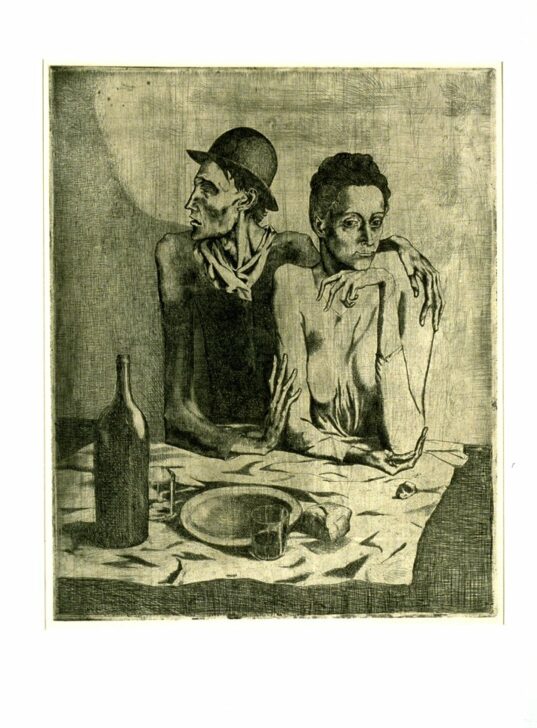Le Repas Frugal
Pablo Picasso; Ambroise Vollard; Louis Fort

Description
Subject Matter:
Designed at the end of his so-called "Blue Period," when the artist was living intermittently between Paris and Spain, this work is one of a series of fifteen works that made up the series called the "Suite des Saltimbanques" or the "Acrobats Suite." These prints originally created between 1904-1906 featured images of circus performers – pointing to his continued interest in performers during the next so-called "Rose Period."
Perhaps referencing Edgar Degas' "Dans un café" (1873), the two sullen figures sit behind a barren still life of table ware. The sunken-in nature of the man's eyes have been suggested to represent his blindness, adding to the sense of isolation and loneliness in the print. Picasso made several portraits of the blind and is said to have been occupied by the thought of blindness. However, the woman's gaze looks out in the viewer's direction, if absent-mindedly.
The design and original printing plate for this work was created in September of 1904. Only a small number of the first edition prints survive (there is an example at MoMA). The printing plate had already been used by the artist Joan Gonzalez to make a landscape when Picasso worked with it, and traces of a stream, reeds, and pebbles can still be seen. In 1913, Ambroise Vollard bought the copper plate. At this time, the plate was stablized with steel facing so a larger edition could be created and Vollard published an edition of 250, an example of which you can see here.
Physical Description:
At the center of the scene, a man and a women sit at a table with an empty plate, two glasses, and a large bottle on the table before them. Their gazes are in nearly opposite directions and they appear gaunt.
Usage Rights:
If you are interested in using an image for a publication, please visit https://umma.umich.edu/request-image/ for more information and to fill out the online Image Rights and Reproductions Request Form.